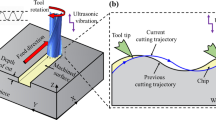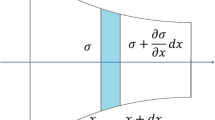Abstract
The purpose of this paper is to investigate the effects of assisted vibration on the drilling quality of aluminium alloy (Al 6061-T6) and structure steel (SS41). In the past, research methodology of vibration drilling on small-diameter holes has mainly involved vibrating from the spindle side. In this paper, a new approach to obtain the desired vibration is proposed from the workpiece side, by a self-made, vibrating worktable. Through extensive experiments with a twist drill size of 0.5 mm, we found that hole oversize, displacement of the hole centre, and surface roughness of the drilled wall could be improved with the increase of vibrating frequency and amplitude. Roundness of the drilled hole could also be improved when high amplitude and proper frequency are imposed.
Similar content being viewed by others
References
Moriwaki T, Shamoto E, et al. (1992) Ultraprecision ductile cutting of glass by applying ultrasonic vibration. Ann CIRP 41(1):141–144
Weber H, et al. (1984) Turning of machinable glass ceramics with an ultrasonically vibrated tool. Ann CIRP 33(1):85–87
Moriwaki T, Shamoto E (1991) Ultraprecision diamond turning of stainless steel by applying ultrasonic vibration. Ann CIRP 40(1):559–562
Wang LJ, Zhao J (1987) Influence on surface roughness in turning with ultrasonic vibration tool. Int J Mach Tools Manuf 27(2):181–190
Kumabe J, Sabuzawa T (1971) Study on the precision drilling of wood (1st report) – profile analysis of drilled hole. J Japan Soc Prec Eng 37(2):98–104 (in Japanese)
Kumabe J, Sabuzawa T (1972) Study on the precision drilling of wood (2nd report) – drilling force and its accuracy. J Japan Soc Prec Eng 38(5):456–461 (in Japanese)
Koyama T, Adachi K, et al. (1977) study on vibratory drilling (2nd report) – comparison of conventional drilling with vibratory drilling. J Japan Soc Prec Eng 43(1):55–60 (in Japanese)
Adachi K, Arai N, et al. (1987) A study on burr in low frequency vibratory drilling – drilling of aluminum. Bull JSPE 21(4):258–264
Takeyama H, Kato S (1991) Burrless Drilling by means of ultrasonic vibration. Ann CIRP 40(1):83–86
Zhang DY, et al. (1994) Study on the drill skidding motion in ultrasonic vibration microdrilling. Int J Mach Tools Manuf 34(6):847–857
Onikura H, Ohnishl O, et al. (1996) Effects of ultrasonic vibration on machining accuracy in microdrilling. Int J JSPE 30(3):210–216
Onikura H, Ohnishi O (1998) Drilling mechanisms in ultrasonic-vibration assisted microdrilling. J JSPE 64(11):1633–1637 (in Japanese)
Jin M, Murakawa M (2001) Development of a practical ultrasonic vibration cutting tool system. J Mater Process Technol 113:342–347
Author information
Authors and Affiliations
Corresponding author
Rights and permissions
About this article
Cite this article
Chern, GL., Lee, HJ. Using workpiece vibration cutting for micro-drilling. Int J Adv Manuf Technol 27, 688–692 (2006). https://doi.org/10.1007/s00170-004-2255-8
Received:
Accepted:
Published:
Issue Date:
DOI: https://doi.org/10.1007/s00170-004-2255-8




